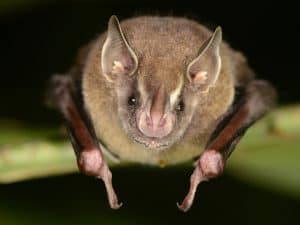Share this article
Omnivorous bats have better evolutionary success
Looking back at the evolution of bats, researchers found that omnivorous species — which consume both plants and animal products — produce more species over time than bats that are specialized in eating only certain plant parts or insects.
Although the study looked back in time, researchers say the finding can offer an important glimpse into bats’ future.
“If you care about climate change, if you care about biodiversity loss, if you care about using insecticides, you need to care about where the bats are and figuring out what they eat,” said Liliana Dávalos, a coauthor of the study published in Ecology Letters and an associate professor at Stony Brook University.

A fruit-eating bat (Artibeus watsoni) is part of large subfamily that’s capable of biting into figs. The bats’ interactions with plants make them important pollinators and seed dispersers in neotropical forests. ©Stephen Rossiter
Dávalos and her colleagues looked at generations of bat data collected around the world from the 1900s to today. “We were able to glean information from field biologists one by one,” she said. “It’s remarkable. Without these generations of people who put in work and look at bats, we wouldn’t have any of this.”
The next step of the research was creating and looking at phylogeny trees —diagrams of how bat species are related to one another. The team looked at how diet changed when the bats branched out to different species. They then looked more closely at the ecology of the different bats to help understand the branching relationships.
The researchers used the data to determine how fast species formed based on what they ate. The fastest rate corresponded with bats that fed on many different food sources, such as fruit, nectar and pollen, and didn’t specialize on one particular plant item. Omnivorous species that ate mostly plants and modestly consumed insects were the most successful, evolutionarily. When a bat specialized on a single plant item or only animals, species formation decreased.
Dávalos has seen the success of an omnivorous bat species before her eyes. She recalls spotting a 40-gram omnivorous Jamaican fruit-eating bat (Artibeus jamaicensis) carrying a fig that it was planning to eat as part of its diet — like a human carrying three watermelons in a blanket. “They’re so small, but they can pierce through figs,” she said.
Header Image: During an expedition in La Selva, Costa Rica, Dávalos and her students analyze the evolution of diet and rate of producing new species in bats. ©Stephen Rossiter








